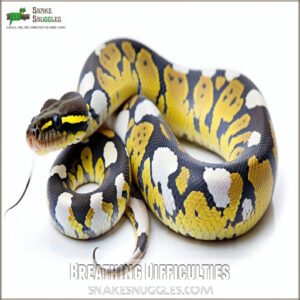This site is supported by our readers. We may earn a commission, at no cost to you, if you purchase through links.

Keep their enclosure clean by replacing water daily and disinfecting monthly. Watch for red flags like open-mouth breathing, wheezing, or mucus discharge.
Maintain proper ventilation to prevent harmful bacteria growth and maintain fresh air circulation. A high-quality filtration system and dechlorinated water are essential.
Regular cleaning, appropriate prey sizing, and consistent feeding schedules can bolster your snake’s immune system. Catching symptoms early could mean the difference between a quick recovery and a serious health issue.
Table Of Contents
- Key Takeaways
- Causes of Respiratory Infections
- Recognizing Respiratory Symptoms
- Treating Respiratory Infections
- Preventing Respiratory Infections
- Common Health Issues in Ball Pythons
- Maintaining Optimal Environment
- Frequently Asked Questions (FAQs)
- How common are respiratory infections in ball pythons?
- What can I give my snake for a respiratory infection?
- How did my snake get a respiratory infection?
- How to prevent respiratory infections?
- Can stress trigger respiratory infections in pythons?
- How do genetics impact respiratory infection susceptibility?
- Are respiratory infections contagious between different reptiles?
- Can environmental changes worsen respiratory symptoms?
- Do seasonal shifts affect respiratory infection risks?
- Conclusion
Key Takeaways
- You’ll need to maintain strict environmental controls for your ball python, keeping temperature gradients between 75-92°F and humidity levels around 50-65% to prevent respiratory infections.
- You’ve got to prioritize daily enclosure cleaning and monthly disinfection, ensuring fresh water, proper ventilation, and a sanitary habitat to reduce bacterial growth and infection risks.
- You’ll want to monitor your python closely for early respiratory infection symptoms like open-mouth breathing, wheezing, mucus discharge, and changes in appetite or energy levels.
- You must reduce your snake’s stress by providing multiple hiding spots, maintaining consistent handling practices, and creating a stable environment that supports its overall immune health.
Causes of Respiratory Infections
Respiratory infections in ball pythons often stem from preventable issues like incorrect temperatures, poor hygiene, or inadequate ventilation.
When their environment isn’t properly maintained, it creates the perfect conditions for bacteria and stress to take over, putting your snake’s health at serious risk.
Incorrect Temperature Levels
Temperature fluctuations can wreak havoc on your ball python’s health.
Keep their enclosure’s gradient in check:
- Basking spot: 88-92°F for proper digestion.
- Warm side: 80-85°F for comfort.
- Cool side: 75-80°F to prevent overheating.
- Thermometer calibration: Verify accurate readings.
- Heat sources: Use reliable ones, avoiding cold spots.
Consistent python temperature is key to preventing respiratory infections.
Poor Hygiene Practices
A dirty enclosure invites trouble—mold growth, mite infestations, bacterial contamination, and filthy substrates can all wreak havoc on your python’s health.
Poor hygiene weakens their immune system, making python respiratory infection prevention nearly impossible.
Daily cleaning, fresh water, and monthly disinfection are non-negotiable, staying on top of sanitation is key to preventing RI in ball pythons and keeping them thriving.
Inadequate Ventilation
Poor hygiene isn’t the only culprit—stale, stagnant air can wreak havoc too.
Without proper ventilation systems, oxygen levels drop, and harmful bacteria thrive, increasing the risk of a respiratory infection in your ball python.
For healthy respiratory health, learn about proper snake housing ventilation.
Guarantee steady air exchange and fresh air flow in their enclosure.
Good air quality is a cornerstone of python respiratory infection prevention and overall health.
Contaminated Water Supply
A contaminated water supply can lead to bacterial contamination and waterborne pathogens, increasing the risk of a ball python respiratory infection.
Regular water quality testing is essential, and to guarantee clean, safe hydration, use filtration systems and dechlorination methods.
Replace water daily to prevent stagnation, and always disinfect water bowls during cleaning, as clean water is key to respiratory infection prevention in reptiles.
Poor Diet and Nutrition
A lack of proper diet can lead to nutrient deficiencies and malnutrition risks, weakening your python’s immune system.
Low-quality food or irregular feeding schedules can stress your snake, making it more prone to respiratory infections.
Prioritize ball python health by offering appropriately sized prey, maintaining consistent feeding schedules, and using dietary supplements to support overall nutrition and ball python care.
Recognizing Respiratory Symptoms
Spotting respiratory symptoms early can make all the difference in your ball python’s health.
Keep an eye out for signs like wheezing, open-mouth breathing, or mucus around their nostrils and mouth.
Breathing Difficulties
Breathing difficulties in ball pythons are a red flag for respiratory infection.
Watch for open-mouth breathing, wheezing, or strange breathing patterns.
These signs point to airway obstruction or tracheal issues disrupting gas exchange.
Left untreated, respiratory failure can occur.
- Symptoms to watch for:
- Open-mouth breathing or wheezing
- Crackling or rattling sounds
- Whistling noises during breaths
- Labored or shallow breathing
Discharge and Mucus
Spotting mucus or nasal discharge is a red flag for a ball python respiratory infection.
Look for bubbly respiratory secretions around the nostrils or mouth—signs of sinus infections or tracheal issues.
Quick action prevents pneumonia in pythons.
| Symptom | Cause | Concern |
|---|---|---|
| Bubbles in nostrils | Sinus infections | Respiratory infection symptoms python |
| Thick mucus | Tracheal issues | Treating RI in ball pythons |
| Discharge buildup | Poor ventilation | Respiratory infection treatment python |
Loss of Appetite
Nasal discharge isn’t the only red flag—food refusal can signal a ball python respiratory infection too.
Loss of appetite often stems from breathing struggles or stress impacting digestive health.
Try appetite stimulants or feeding strategies like offering smaller, warmed prey.
Nutritional supplements might help, but don’t wait long—untreated respiratory infection symptoms in pythons can worsen, risking pneumonia or severe health issues.
Lethargy and Weight Loss
If your ball python seems sluggish or sheds weight, it’s waving a red flag.
Respiratory infections can sap energy, leading to metabolic issues and energy loss.
Watch for changes in snake behavior, as malnutrition risks grow with feeding struggles.
Adjust feeding strategies and seek help quickly—treating RI in ball pythons early is key to avoiding serious harm.
Treating Respiratory Infections
When your ball python shows signs of a respiratory infection, prompt treatment is essential to prevent complications.
By combining proper enclosure conditions, veterinary care, and prescribed medications, you can help your snake recover and breathe comfortably again, which is crucial for its overall health and well-being, especially in relation to proper enclosure conditions.
Antibiotics and Medication
Treating RI in ball pythons often requires antibiotics like Enrofloxacin or Ceftazidime, prescribed by a vet.
Proper dose administration is vital to avoid antibiotic resistance. These medications are slow-acting, so treatment duration may stretch weeks.
For more information, see this overview of reptile respiratory infections.
Always discuss potential drug interactions with your vet, and pair antibiotics with supportive care to tackle the infection and boost your python’s recovery.
Optimal Temperature and Humidity
Your python’s health hinges on proper climate management.
Maintain thermal gradients—88-92°F for basking, 75-80°F for cooler zones—to support their immune system.
Consistent python humidity, around 50-65%, prevents respiratory stress.
Invest in reliable temperature control and ventilation systems to avoid stagnant air.
A ball python thermostat helps regulate these conditions.
Regularly monitor these levels; ball python husbandry thrives on precision, not guesswork.
Proper Hydration and Nutrition
After setting the right temperature, focus on hydration and nutrition to boost your python’s health. Poor water quality or a lack of nutrient balance can worsen respiratory issues.
Here’s how to help:
- Use fresh, clean water daily.
- Monitor hydration methods.
- Offer prey with proper size and variety.
- Add dietary supplements like calcium.
- Avoid overfeeding.
Veterinary Care and Consultation
If hydration and nutrition don’t improve your python’s condition, it’s time to call a reptile veterinarian.
Proper husbandry is vital for preventing many health issues, so understanding ball python care guides is essential.
Veterinary care guarantees proper medical diagnosis and treatment, like antibiotics or inhalation therapy.
Snake vets or animal hospitals can handle severe cases, preventing pneumonia in pythons.
Pet insurance helps with costs, so don’t wait—emergency care could save your ball python’s life.
Preventing Respiratory Infections
Keeping your ball python healthy starts with preventing respiratory infections through proper care and attention.
By maintaining the right enclosure conditions, practicing good hygiene, and reducing stress, you can protect your snake from unnecessary illness, which is crucial for its overall health and wellbeing, related to the concept of proper care.
Proper Enclosure Size and Ventilation
A cramped enclosure is like breathing through a straw—stressful and unhealthy.
Give your ball python breathing room with proper space requirements and a smart enclosure design.
Ventilation systems are key for air flow management, preventing stagnant air that invites a reptile respiratory infection.
Choose setups promoting airflow, like screen tops or vents, to balance python humidity and reduce respiratory infections.
Regular Cleaning and Disinfection
Keeping your python’s enclosure spotless is non-negotiable for respiratory infection prevention.
Stick to strict cleaning schedules—daily spot cleaning and monthly deep disinfection.
Use reptile-safe disinfectant types to tackle mold, mites, and bacteria.
You can find effective reptile safe disinfectant products online.
Sanitation methods like substrate changes and wiping surfaces guarantee hygiene protocols are met.
Enclosure maintenance isn’t glamorous, but it’s your best defense against a ball python RI.
Balanced Diet and Nutrition
A balanced diet is key to your ball python’s health.
Prioritize food variety and nutrient requirements to boost python health.
Stick to a feeding schedule, ensuring prey matches your snake’s girth.
Dietary supplements like Vitamin D and Calcium improve immunity, while proper vitamin intake reduces respiratory infection risks.
Nutrition isn’t optional—it’s essential for ideal reptile health and long-term wellbeing, with proper vitamin intake being crucial.
Stress Reduction and Management
Stress weakens your ball python’s immune system, increasing the risk of respiratory infections.
Stick to gentle handling methods and consistent socialization strategies to build trust.
Provide environmental enrichment, like sturdy hides and proper python humidity levels.
Creating a humidity gradient, as discussed in this guide to preventing respiratory infection, is essential for maintaining ideal conditions.
Calming techniques, such as maintaining ideal temperature ranges, create a relaxing space.
Relaxation practices keep your snake’s environment secure and support long-term ball python health.
Common Health Issues in Ball Pythons
As a ball python owner, you’ll want to stay informed about the potential health challenges your scaly friend might face.
Understanding common health issues like respiratory infections, mouth rot, and external parasites can help you provide the best care and catch potential problems early.
Mouth Rot and Viral Infections
Almost every ball python owner fears mouth rot and viral infections that can silently threaten their pet’s health.
These bacterial and viral challenges can transform a thriving python into a struggling snake through oral lesions, foaming symptoms, and disease transmission.
Prompt veterinary intervention, maintaining ideal humidity, and practicing rigorous enclosure hygiene are your best defense against ball python respiratory infection risks.
External Parasites and Mites
Blood-sucking snake mites can turn your ball python’s world upside down in a heartbeat. These tiny parasites are more than just a nuisance—they’re a serious health threat .
- Watch for tiny black or red dots around your snake’s eyes and scales
- Inspect enclosure for excessive rubbing or unusual soaking behavior
- Use veterinarian-approved mite treatments carefully
- Completely disinfect the entire habitat
- Quarantine new reptiles to prevent parasite spread
This set of instructions is crucial for maintaining the health of your ball python, as blood-sucking snake mites can cause significant harm, and it’s essential to take preventive measures, including quarantine to prevent the spread of parasites.
Blister Disease and Skin Infections
If something seems off with your ball python’s skin, you might be facing blister disease.
This painful condition strikes when humidity and bedding go wrong, causing fluid-filled lesions that can quickly turn serious.
Watch for ulcers, necrotic patches, and potential infections.
Immediate veterinary care with antibiotics, careful cleaning, and precise habitat management are your best defense against these bacterial and fungal threats.
Incomplete Skin Shedding
After battling blister disease, your ball python might face another scaly challenge: incomplete skin shedding.
Dysecdysis can strike when humidity drops or terrariums lack proper rubbing surfaces.
Watch for retained eye caps and skin patches—telltale signs your snake’s shedding process is stuck.
Boost humidity, provide moisture-rich environments, and regularly check your python’s scale health to prevent these tricky skin issues, related to dysecdysis.
Maintaining Optimal Environment
Creating the right environment is essential for your ball python’s health and preventing respiratory infections.
You’ll want to carefully manage temperature, humidity, and cleanliness to keep your scaly friend breathing easy and thriving, which involves maintaining the right humidity.
Temperature and Humidity Control
After spotting health issues in your ball python, mastering thermal gradients becomes your secret weapon.
Monitor temperature with precision: basking areas need 88-92°F, warm zones 80-85°F, cool sides 75-80°F.
Use digital hygrometers to track humidity between 50-60%.
For more detailed guidance, explore effective snake enclosure humidity control.
Heat mats, tapes, and strategic misting help maintain the perfect climate, keeping respiratory infections at bay and your scaly friend thriving.
Providing Hiding Spaces and Reducing Stress
After nailing the perfect temperature and humidity, you’ll want to master your ball python’s sanctuary design.
Reducing stress is key to preventing respiratory infections.
Here’s how to create a snake-zen zone:
- Install multiple hiding spots across temperature gradients
- Use natural-looking materials like cork bark or branches
- Minimize loud noises and sudden movements
- Keep handling calm and predictable
A stress-free snake is a healthy snake.
Monitoring and Maintaining Cleanliness
After creating cozy hiding spots, keep your ball python’s home sparkling clean.
Regular sanitation protocols are your secret weapon against respiratory infections.
For specialized cleaning products, explore a ball python cage cleaner product selection.
Stick to a strict cleaning schedule, disinfecting the enclosure monthly and removing waste daily.
Proper hygiene practices aren’t just about looks – they’re about keeping your scaly friend healthy and breathing easy, which is crucial for maintaining proper hygiene and ensuring a healthy environment.
Ensuring Proper Hydration and Nutrition
After keeping your enclosure squeaky clean, it’s time to focus on your ball python’s water quality and diet.
Provide fresh, clean water daily and choose high-quality food supplements that match your python’s nutrient balance.
Monitor humidity levels and make certain proper hydration methods, as a well-fed python with balanced dietary needs is less likely to develop respiratory infections due to good hydration.
Frequently Asked Questions (FAQs)
How common are respiratory infections in ball pythons?
When Jake’s python, Slither, struggled to breathe, he realized respiratory infections are surprisingly common.
You’ll face these challenges often, with up to 30% of captive ball pythons experiencing respiratory issues during their lifetime.
What can I give my snake for a respiratory infection?
You’ll need a vet’s prescription for antibiotics.
Don’t try home remedies; professional treatment’s essential.
Your snake’s respiratory infection requires oral or injectable meds, plus identifying and fixing the underlying environmental cause.
How did my snake get a respiratory infection?
Just like a cold spreads in a crowded office, your snake caught its respiratory infection from poor habitat conditions.
Incorrect temperatures, low humidity, dirty enclosures, and stress can quickly compromise your reptile’s health.
How to prevent respiratory infections?
Optimize your python’s habitat with precise temperature control, consistent humidity levels, daily enclosure cleaning, and stress reduction.
Regular vet check-ups, proper diet, and vigilant observation are your best defense against respiratory infections.
Can stress trigger respiratory infections in pythons?
Like a ticking time bomb, stress can absolutely trigger respiratory infections in ball pythons.
When your snake feels overwhelmed, its immune system weakens, making it more vulnerable to dangerous bacterial and viral respiratory complications.
How do genetics impact respiratory infection susceptibility?
Your python’s genetic makeup can influence its respiratory infection risk. Some bloodlines are more susceptible due to inherited immune system variations, making careful breeding and health monitoring essential for prevention.
Are respiratory infections contagious between different reptiles?
Imagine reptile viruses as party crashers hopping between tanks! Yes, respiratory infections can spread between different reptile species through direct contact, shared habitats, or contaminated equipment. Veterinary isolation is essential.
Can environmental changes worsen respiratory symptoms?
Yes, environmental changes can definitely worsen respiratory symptoms in reptiles. Sudden temperature drops, high humidity, and poor ventilation can stress your snake’s immune system and aggravate existing respiratory issues.
Do seasonal shifts affect respiratory infection risks?
Changing seasons strain your ball python’s immune system.
Temperature drops, humidity shifts, and indoor heating can weaken respiratory defenses, increasing infection risks.
Stay vigilant, maintain stable habitat conditions, and monitor your snake’s health closely, to prevent issues related to respiratory defenses.
Conclusion
Ultimately, preventing respiratory infections in ball pythons isn’t just about treatment—it’s about proactive care.
You’ll need to stay vigilant, maintaining ideal habitat conditions, monitoring your snake’s health, and addressing potential issues swiftly.
By understanding their unique needs, providing a clean environment, and seeking veterinary guidance when necessary, you’ll give your ball python the best chance at a healthy, thriving life.
Remember, your commitment makes all the difference in their well-being.
- https://thepetenthusiast.com/ball-python-respiratory-infection/
- https://vcahospitals.com/know-your-pet/snakes-diseases
- https://reptifiles.com/ball-python-care-guide/ball-python-diseases-health/ball-python-respiratory-infection/
- https://bamboozoo.weebly.com/snake--respiratory-remedy.html
- https://www.terrariumquest.com/ball-python/respiratory-infection/


















